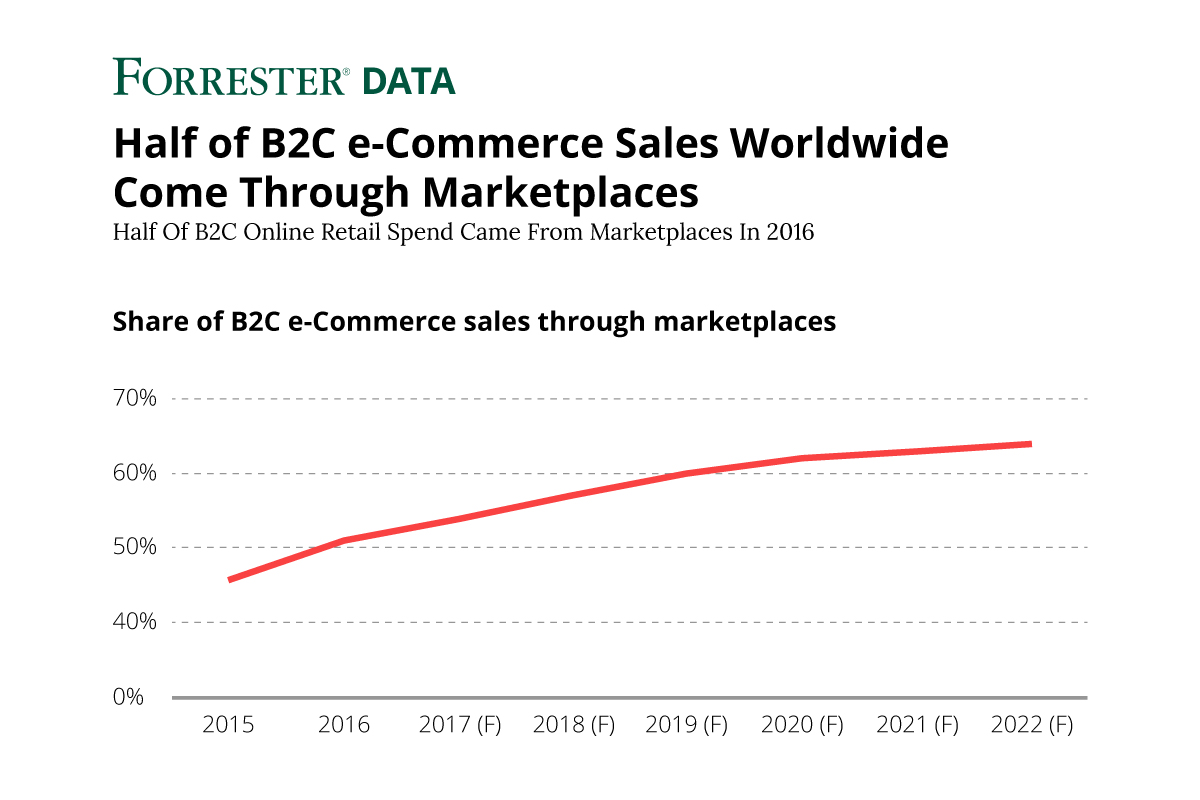
A marketplace is not a wholesaler or a retailer; it’s neither a shop nor a warehouse, rather it’s a well-placed, revenue-sharing model that connects people who want to buy goods and services with people who sell them.
In other words, marketplaces are created to facilitate the growing number of businesses that want to sell online but lack the expertise or resources to create their own store. These allow third-party vendors to sell directly to end-users in a safe and secure manner. The platform does not own or store any of the inventory, but it handles the payment to restrict any fraudulent activities by sellers as well as buyers.
And this is exactly how major players like Amazon, eBay, and Alibaba have been able to quickly scale up — as an added advantage, these marketplaces provide customers with a broad selection of offerings under one roof.
Amazon Is Reaching for Higher Grounds
Amazon realized the importance of the marketplace model a while back — in fact, as per Bloomberg, the company has tripled its revenue since 2010. One of the main reasons for their success is the fact that they started moving away from in-house inventory and invested more in on-boarding third-party vendors. This allowed them to expand their marketplace, where third-party sellers recorded $118.57 billion in sales in 2018 — a 25.2% jump from 2016.

Figure 1 – According to Forrester, 66% of e-commerce sales will come from marketplaces by 2022.
Individual Brands Within a Marketplace
Even with the multitude of online shopping platforms, competition has grown exponentially as businesses realize the potential of marketplaces. But for third-party vendors to effectively compete in this market, they need a proper strategy and approach towards increasing sales.
Without a plan, they may not be able to compete against businesses that are selling the same products. They need to decide how low they should proceed in case of a price war, and what tactics they need to implement to increase their ratings and rankings.
But while there are a lot of positives in joining a marketplace, the real cost that third-party sellers need to consider is this: They essentially lose their ability to control their brand and overall customer experience.
Here are some key areas that third-party vendors need to consider:
Customer Experience
The buying process is an experience on its own, from discovery to accepting the parcel at the door.
You can see how important it is for brands like Apple, who put so much effort into their in-store pre-sale process, packaging design, and ‘press one button and you’re ready’ experience. The problem with a marketplace model is, as a brand operating on a platform like Amazon, the experience doesn’t really belong to you, it belongs to the platform. For example, if you’re a high-end brand whose competitive advantage relies on a delightful experience (such as Apple), selling on Amazon could conflict with your strategy. The reason being, Amazon’s checkout process has always been about the speed of purchase. Their primary goal isn’t to sweeten and delight you, it’s to make buying from them as easy as possible. When you receive your item, it’s in their bog-standard cardboard packaging with your item wrapped in cheap bubble-wrap. As a result of this, some of the magic of your brand is lost.
This should be a concern as increasingly user-experience is becoming a more important purchasing-factor than even price or quality. What brands should be considering when they are selling through marketplaces is how they are still able to provide a delightful, remarkable, and memorable user-experience which attracts a repeated purchase or at least pushes the customer over to a channel they are more in control of, such as their own website or social media.
Customer Insights
One-to-one customer interaction is always better as it can help you understand their needs, wants, and interests. In turn, this can help create an excellent brand that attracts loyal customers and turns them into advocates. But this type of direct interaction is not an option on online marketplaces, because the relationship typically belongs to the marketplace. As a result, the brand may lose out on valuable customer data that they would typically get through other channels. For example, on social media, you can gauge from comments what your customers like and don’t like. Equally, you can use website data to see how people use your website and what type of messaging they respond to, to help improve your product.
Marketplace data is somewhat more restricted, and that’s why it’s still important to invest in other channels beyond just selling on places such as Amazon, eBay, and Rakuten.
Opportunity Cost
Winning sales on marketplaces requires a high ranking on the listings. Whilst every marketplace is different, what it typically boils down to are factors like your reputation (usually customer review), CTR, product titles/descriptions, and the number of successful sales.
This, of course, takes months, sometimes years to gain — and it’s no easy feat. It can take a lot of time and a hell of a lot of effort. In many ways, it’s similar to SEO. You build your reputation with the search engines, and in return, you gain your rank as a sort of ‘asset’, which can be used to drive sales for your business. But much like SEO, it only gets tougher in time. In the early days of Google Search, it was somewhat easy to rank for whatever you wanted because it was easy to game the system and competition was pretty scarce. However, over the years, as search engines became more sophisticated and there were more websites to rank, SEO became far less predictable as to where you’d rank, and if you’d rank.
Which brings me to my next point. Let’s say that you do rank. For how long will you stay there? Such is the competitive nature of search listings that just as easy as you come, you can go — ask any SEO agency. The other issue is that you’re totally at the mercy of the platform’s own strategy. When Google switched their algorithm to rank websites based on links and less on keywords (Panda, Penguin & Hummingbird), in a crackdown on websites gaming the system, it literally destroyed businesses overnight.
My point is, marketplaces make it appear easy on the outside. Submit your products, and in come the sales. However, it is so far from this. It requires a lot of effort and there is a risk attached to that, and one day you’ll either be dethroned by a competitor or the marketplace’s algorithm. That’s why it is so important to have digital assets that exist outside of marketplaces that you are completely in control of, such as a Facebook group, email list or website.
Market Foresight
As per Absolunet, marketplaces like Alibaba, eBay, Rakuten, and Amazon are dominating the digital market with trade worth $1 trillion dollars, making up 40% of the global retail market.
However, I don’t think this is one of those winner-has-taken-all situations. There are still ample opportunities for new marketplaces and we really are still at the beginning of the marketplace revolution.
The reason I believe this is because while history doesn’t repeat itself, it sure does rhyme. Craigslist can be compared somewhat to a modern-day marketplace, where you could find anything from jewelry to jobs local to you. Whilst incredibly convenient, the issue was that because it was something-to-everyone, it wasn’t really a specialist to anyone. As a result, it was picked apart by brands that could deliver on Craiglist’s users’ exact needs.

The most famous story of this is Airbnb, who actually used Craigslist to find their first customers. I believe that this is already happening to large marketplaces in the shape of more ‘vertical-marketplaces’ which are more focused — such as Etsy and FarFetch.

Why these marketplaces are so hard to compete with is that they have such a deep product/service offering that grants a different kind of convenience centered around providing variety. Moreover, as they’re more focused, they’re far more likely to respond to new customer insights and trends and get new products to their audience quicker. However, one thing that cannot be underestimated is the vast resources Amazon has as well as the huge consumer trust. For this reason, I believe they will remain a superpower for many years to come, but perhaps not as dominant as they currently are.
Conclusion
As a third-party seller, I do think it is necessary to participate in marketplaces. I also think it is incredibly important to spread your eggs across multiple baskets. But I do not think they should be only your sales channels — I think it is equally important to invest time and effort into marketing assets you are able to better control, for example, your website, social media, and email list.
I believe there is a vast amount of opportunity in smaller and niche marketplaces, which have less competition and if you’re able to gain traction in them the listing clout you obtain could be worth thousands in future revenue.
Image source: Bench Accounting